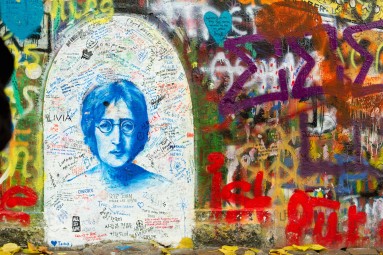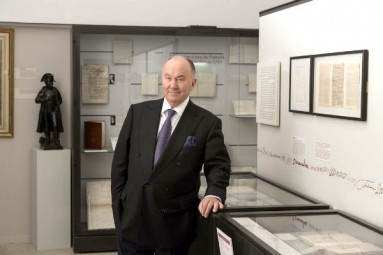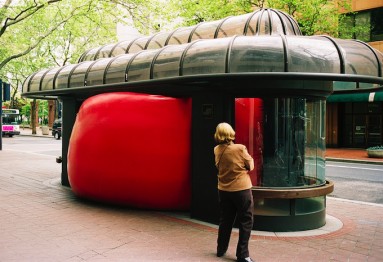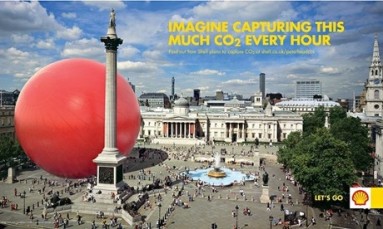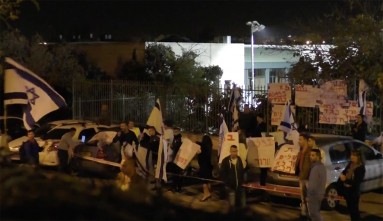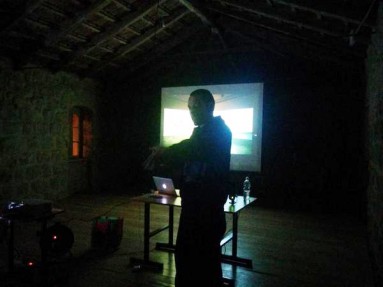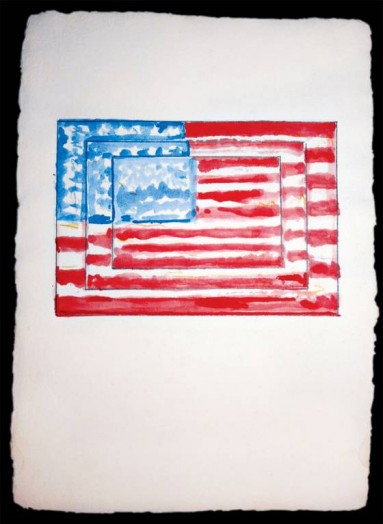The so-called John Lennon Wall in Prague, which, since its namesake’s assassination in 1980, has been a popular destination for tourists, taggers, and street artists, was completely erased with white paint on Monday by an artist collective calling itself Prague Service.
Buffing years of accumulated graffiti, the group left the wall entirely white save for the sentence “Wall Is Over!,” the AFP reported, an allusion to the subtitle of Lennon’s song “Happy Xmas (War Is Over).” The artists timed their white-washing to coincide with the 25th anniversary of the Velvet Revolution — the nonviolent uprising that led to the end of Communism in Czechoslovakia — and said they hoped that their gesture would “offer a free space for the messages of a rising generation,” according to the AFP.
It didn’t take long for others to take advantage of the free space and begin filling the Lennon Wall with tags again. However, the wall’s owner, the Order of Malta, was not so quick to dismiss the incident, and is pursuing legal action against the artists.
(via)
• • •
The company is suspected by the tax authorities and Tracfin—a public body fighting money laundering and terrorism financing—of “deceptive marketing practices," and “gang fraud." At time of writing, the Aristophil website as well as the websites for the museum and the institute appear to have been taken offline.
The implications of the case are far-reaching, and could have significant impact on the rare manuscripts world as a whole. According to Le Parisien, Lhéritier owns five percent of the global books, letters, and manuscripts market, worth an estimated €3 billion a year.
For years, Lhéritier's company Aristophil has been aggressively buying, paying top dollars for pieces including the Marquis de Sade's The 120 Days of Sodom and Napoleon's Wedding Certificate
The collection is worth between €400 million and €500 million depending on the source. It has been leveraged via an investment scheme, which the French press have likened to a Ponzi scheme, a type of financial scam made famous by Bernie Maddoff.
(via)
• • •
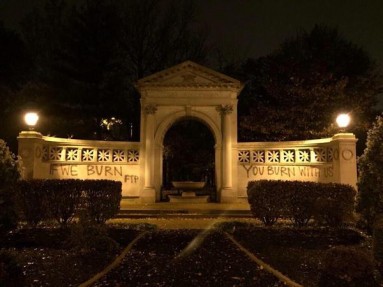
• • •
Perschke created the red ball project in 2001 and has taken it to more than 20 cities, including this year Montreal, Rennes and Galway. Next year it will go to Singapore and, Perschke hopes, to Wales. When it came to London as part of the Cultural Olympiad, the balls appeared on the Millennium and Jubilee bridges over the Thames.
“The piece is about playing with the architecture of the city,” said Perschke. “It is about imagining what can happen in a city, it is about playing.”
Last week Perschke was alerted to the Shell billboard poster campaign which uses even bigger red balls. One is pictured behind Nelson’s Column in Trafalgar Square, and another next to the Forth bridge in Scotland. They come with the tagline: “Imagine capturing this much CO2 every day.”
Shell denied it was using Perschke’s concept. “This Shell campaign uses red spheres as a visual device to illustrate the volume of CO2 that the Peterhead CCS project is designed to capture each day. It is intended to help consumers understand through a simple visual representation the importance of capturing CO2 for a better energy future,” a spokesperson said.
“The campaign uses imagined illustrations of a red sphere in iconic locations. They are not actual or physical installations of red balls, which is the focus of the artist’s installations.”
(via)
• • •
In his work, Zaides traces the body language and movement of soldiers and settlers who are filmed by Palestinians. The connection between the adoption of the Palestinian perspective and the movements of the Israeli solders or settlers allow him to emphasize the physical reactions to which they resort to in various confrontational situations. Zaides wished to examine the somatic influence of the Israeli Occupation on the bodies of those administering it, while raising questions about his own involvement in the act.
With the exception of the electrical sabotage and shouts coming from outside, the talks proceeded with little interference for those of us in the hall. Suddenly we see people throwing stones at the windows. The police rushed to the location of disturbance, and discovered that the protesters appeared to have broken the security camera at the entrance.
The evening ended with questions from the audience, but the tension made it difficult to concentrate. Before leaving the room, a security officer instructed the audience to avoid conflicts and not to take any pictures. As they left our guests were cursed and taunted in a shocking way. Arkady and Ruthie stayed inside for an additional 20 minutes, and left only with a police escort that accompanied them to their car. Through the windows we saw protesters running down the street in all directions, we decided to leave later — and only after police reported that the protesters had dispersed. The right-wing Israelis yelled at the Jewish Israeli attendees all types of obscenities, including “You Nazis, we’ll make soaps out of you,” “You fucker, you leftists,” and “You need to go to Gaza.”
Later on we heard reports from friends and guests about harsh verbal and physical violence. A friend, who was stuck outside with the protesters, was punched in the stomach, and a woman was beaten with a flag pool on her head, but all are ok now. All the people I spoke to were very shaken by what happened.
Here in West Jerusalem the police protected us. A few protesters were arrested and released the following day, however we don’t believe the police filed a report. During the same period, in East Jerusalem, protests and riots by Palestinian youth continued, and the police continued to shoot tear gas and stink bombs at the protesters, while beatings and arrests were frequent. In Gush Etzion, a young woman was murdered by a Palestinian, and a security guard was stabbed on the light rail. The next morning the walls of the bilingual school, the only place in Jerusalem were Arab and Jewish children learn together (and some of our children and the children of our friends go there), were graffitied with “Death to the Arabs” slogans. Just another November day in Jerusalem.
(via)
• • •
In February 2012, word trickled out around Sharon and Lakeville that Jim Meyer wasn’t working for Jasper Johns anymore. It didn’t take long for Meyer’s friends in the local art community to hear the reason, though the details were vague. “Someone emailed an image to check against the catalogue raisonné, and it got back to Jasper,” one friend of Meyer’s says. Johns “knew immediately it was not something he permitted. Jim was fired that day.”
Naumann was shocked, he says, and puzzled. The artwork that exposed Meyer was not the drawing that Naumann had helped his client Kolodny buy. Naumann spent more than a week unsure of what to do. Finally, he says, Johns called him and politely asked Naumann to tell his lawyer everything he knew about what had happened. Naumann, relieved, said he’d be happy to. During that call, Johns said something that astonished him: Meyer had mailed Johns back one of the stolen drawings. Naumann told Johns that he hoped he kept it in its original paper. “If somebody mailed back a drawing, isn’t that a clear acknowledgment that you were the thief? Isn’t that, like, admitting to it immediately?”
For 18 months, Meyer and his family proceeded as if nothing were wrong, at least outwardly. Meyer mounted two different exhibitions of his own art—at the Hotchkiss School and Gering & López on Fifth Avenue. Meanwhile, he quietly transferred ownership of the Lakeville house to Amy’s name. When the indictment was finally unsealed in August 2013, Meyer stood accused of stealing 22 artworks, some unfinished, between 2006 and 2012. They all apparently had come from the same drawer in Johns’s studio, a drawer Meyer maintained. Meyer was said to have created fictitious inventory numbers for the pieces — and, for certain sales like Kolodny’s, fake pages in the ledger book. The pieces brought in $6.5 million, with Meyer pocketing $3.4 million.
(via)

